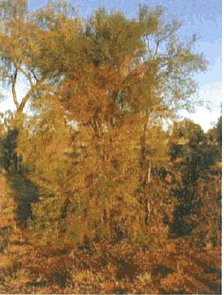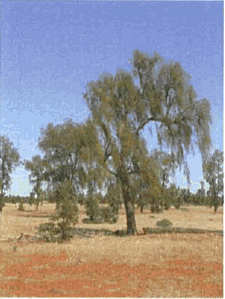
Fig 1. Acacia peuce seedling (juvenile form)

Fig 2. Acacia peuce juvenile form. The juvenile form of the waddi tree produces abundant fuel (Figs 1 and 2), unlike the mature form seen in Fig 3.

Fig 3. Acacia peuce mature form. .
Summary of final report on the Australian Flora Foundation funded project:
Jon Luly1, Joe Holtum2 and Michelle Waycott3
1School of earth and Environmental Sciences, James Cook University Townsville Q 4811
2School of Marine and Tropical Biology, James Cook University Townsville Q 4811
3State Herbarium of South Australia
The waddi tree stand at Boulia is the most numerous of the three known localities in which the tree grows. The stand comprises somewhere around 100,000 individuals and has extended geographically, and in density since the 1970s. The stand maintains a high genetic diversity and is actively recruiting. We believe it to be in good health.
Waddi trees recruit opportunistically and depend on canopy seed storage to supply seeds, most of which die unless there has been above average rainfall. Seedlings send down a rapidly growing tap root in order to keep up with subsidence of the soil wetting front. They establish best on sandy sites which allow rapid root penetration and extraction of water at low soil water potentials but do not persist on source bordering dunes. There are indications that waddi trees can reproduce by suckering from shallow horizontal roots. The extent of asexual reproduction in the stand has yet to be fully evaluated. The horizontal roots probably play a water storage function in addition to acting as reservoirs for buds. The anatomy and function of shallow roots is under active investigation.
Grazing activity is not presently affecting the health of the stand. Cattle, kangaroos and camels browse foliage, devour seedlings and trample roots however they also reduce the significant risks to the stand posed by uncontrolled fire. Waddi trees exhibit structural adaptations to browsing by vertebrates and we believe this to contribute to their resilience to grazing in this the wettest part of their range.
Waddi trees do not appear to be extremely long lived. Radiocarbon dating suggests that the majority of large trees are approximately 200 years old. Some exceptional individuals may live longer but the beginning of senescence in trees of the sizes dated suggests that the majority would die inside 300 years.
Water use studies suggest that waddi trees are strongly drought adapted and their scarcity at a landscape scale does not reflect confinement to refugial habitat by water stress. There are indications that waddi trees use water differently from potential competitors such as Grevillea striata and this will be one of the areas of focus for continuing research on the species.
